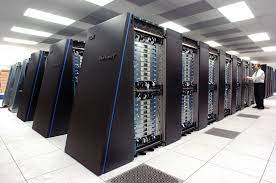SUPER COMPUTER: WORLD & INDIA

- Science & Technology
- Comment 0
SUPER COMPUTER: WORLD & INDIA
In present era supercomputers are made up of thousands of connected processors, and their speed has grown exponentially over the past few decades. The first supercomputer, released in 1964, was called the CDC 6600. It used a single processor to achieve 3 million calculations per second. While that may sound impressive, it is tens of thousands of times slower than an iPhone.
The Summit consists of over 36,000 processors from IBM and Nvidia that can perform 200 quadrillion calculations per second. In comparison to any typical computer can do in 30 years Summit will be able to accomplish in just an hour.
Summit takes up 5,600 square feet of floor space and has nearly 200 miles of cable. It uses 4,000 gallons of water per minute to stay cool and consumes enough power to run 8 thousand homes.
Supercomputers are used for functions like forecasting weather and climate trends, simulating nuclear tests, performing pharmaceutical research and cracking encryption keys. Some initial projects on deck for Summit include researching possible genetic predispositions to cancer or opioid addiction.
Note: In the meeting of Supercomputer Conference 2018 held on 11 to16
Super Computers in India
Pratyush (World record 45th rank): The latest supercomputer at IITM,Pune “Pratyush” is a Cray-XC40 LC [Liquid Cooled] System with 3315 nodes running Intel Xeon Broadwell E5-2695 processors with a peak performance of 4,006 TFLOPS and a total system memory of 414TB. The system is composed of 18 Compute cabinets and uses Cray’s Aries NOC with Dragonfly Interconnect network topology. In addition, the system consists of 16 Intel KNL 7210 accelerator nodes with a peak performance of 42.56TFLOPS and a total memory of 1.5TB.
The entire system operates on Cray’s customized Linux OS, called Cray Linux Environment. The cluster supports architecture specific compilers from Cray as well as Intel and open-source GNU compilers. System also hosts architecture specific parallel libraries like OPENMP, MPI, libsci, Intel Cluster software etc. Applications like GFS, WRF,ROMS,CFS are available on the system for weather forecasting. To facilitate users with parallel program development, DDT parallel debugger and profiler is enabled on the system. The system uses PBS Pro as Workload Manager.
Mihr (World record 73rd rank ): Mihir is the fastest supercomputer in India with a maximum speed of 6.8 petaflops at a total cost of INR 438.9 Crore working at National Center for Medium Range Weather Forecast (NCMRWF) Noida.
SRECC (World Record 488th rank): Functioning at Indian Institute of Science
PARAM Yuva II: Unveiled on 8 February 2013, this supercomputer was made by Centre for Development of Advanced Computing in a period of three month. It performs at a peak of 524 TFLOPS, about 10 times faster than the present facility, and will consume 35% less energy as compared to the existing facility. Param Yuva II used for research in space, bioinformatics, weather forecasting, seismic data analysis, aeronautical engineering, scientific data processing and pharmaceutical development. Educational institutes like the Indian Institutes of Technology and National Institutes of Technology can be
linked to the computer through the national knowledge network. This computer is a stepping stone towards building the future petaflop-range supercomputers in India.
SAGA: SAGA built by ISRO, is capable of performing at 450,000 gigaflop/s (450 teraflop/s). It uses about 400 NVIDIA Tesla C2070 GPUs and 300 NVIDIA Tesla M2090 GPUs for acceleration and 400 Intel Intel QuadCore Xeon CPUs and 330 Intel Intel HexCore Xeon CPUs for proceesing. Storage Capacity is 120 TeraBytes.
EKA: EKA is a supercomputer built by the Computational Research Laboratories with hardware provided by Hewlett-Packard. This is developed by Tata sons. It is capable of performing at 132800 gigaflop/s or 132 teraflop/s.
VIRGO: Indian Institute of Technology, Madras has a 91.1 teraflop/s machine called Virgo. It is ranked as 364 in the Top 500 November-2012 list. It has 292 computer nodes, 2 master nodes, 4 storage nodes and has total computing power 97 TFlops. According to Linpack Performance, Virgo is the fastest cluster in an academic institution in India. In terms of performance, it has an Expand (Rmax) of 91.126 TF and Expand (RPeak) of 97.843 TF. The computing efficiency is 932 Expand (MFlop/Watt). As of 2012, Virgo is at 224th position in the world (Top500), 5th ranked energy efficient machine in the world and 1st ranked energy efficient machine in India.
Vikram-100: Inaugurated on 26 June 2015, by Prof. U. R. Rao at the Physical Research Laboratory, the Vikram-100 is a High Performance Computing (HPC) Cluster (named after eminent scientist Dr Vikram Sarabhai) with more than 100 teraflops of sustained performance. Currently, the Vikram-100 HPC is 13th fastest supercomputer in India.
Cray XC40: SERC IISc has procured the super computer XC40 from Cray Inc. It was up for trials up to 25 January 2015.
November,in Middle America at Texas State, the list of 500 Super computer was launched in which four computers were
from INDIA.
Comments 0